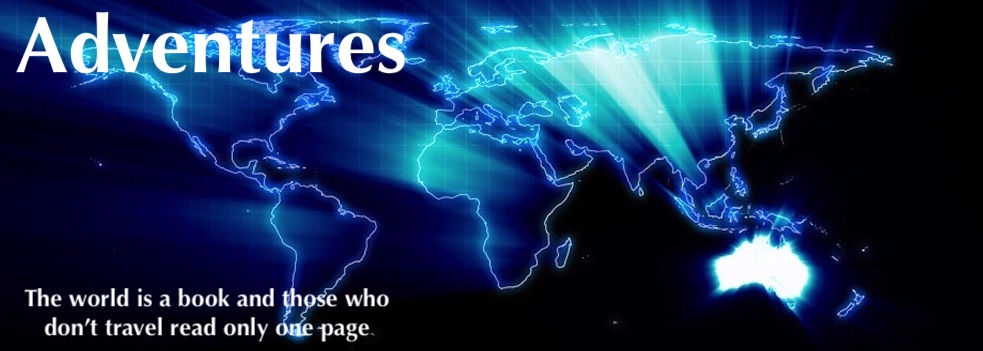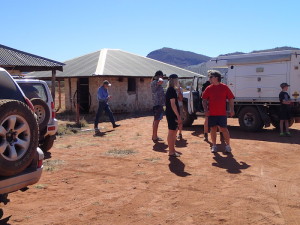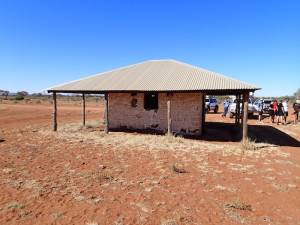A four day, four night tour of the Murchison with a visit to Mount Augustus, the world’s largest monocline, as the highlight.
Eleven people in six vehicles left Perth on 3 October 2013, headed for Mount Augustus. A Thursday evening departure enabled us to drive beyond Wubin, and camp about 300 kilometres north of Perth.
- Bush camp at Wubin.
- The light was fading fast as we setup camp.
- Plenty of room.
- Nothing elaborate – quick getaway in the morning.
The first stop was Paynes Find, scene of a gold rush in 1911. Named after the prospector, Thomas Payne, who was the first to discover gold in the area, the town prospered into the 1930s when the population was estimated to be about 500.
- Paynes Find Gold Battery.
- Hopper ramp.
- The six vehicles at the Paynes Find battery.
- The conveyor fed ore into the battery.
But today little remains other than a roadhouse/bar/motel and a few other buildings, including a state gold battery. The area is renowned for its wildflowers, but we were a little bit too late in the season to see them.
- Queen of the Murchison Hotel
Next stop was Cue, known as the Queen of the Murchison. Gold was found here in 1892 and the town that grew up around the find was named after Tom Cue, one of the prospectors involved in the claim.
- The iconic Cue Rotunda in the main street
By around 1900 Cue was the centre of the Murchison goldfields and boasted a population of about 10,000. After World War 1 many of the mines did not reopen and this started the decline of Cue as a major population centre. After the Great Depression and the fall in the price of gold the population of Cue had dropped to fewer than 500.
- Murchison Club Hotel
- Queen of the Murchison Hotel
- Bells Emporium
- Cue Motors
- Cue Hotel
- Cue Police Station.
- Bank building at Cue.
Cue is heritage listed as a town of significant historical value. The main street has changed little since it was first built. There are several buildings within the townsite that are icons in their own right.
We left Cue to drive to Walga Rock and Big Bell.
- Outside Cue.
- Mike and Harrison.
- The start of red sand country.
- On the road to Walga Rock.
Walga Rock is the second largest monolith in Australia after Uluru. It is a 1.8 kilometre long ‘whaleback’ located about 50 kilometres south-west of Cue. Walga Rock has the largest known gallery of Indigenous art in Western Australia.
- The overhang at Walga Rock.
- Welcome to Walghanna.
- Tafone at Walga Rock.
- Walga Rock
- Tafone at Walga Rock.
- Walga Rock
- Walga Rock
A painting of what appears to be a sailing ship, under which there are lines of writing resembling Cyrillic or Arabic; superimposed over some of the earlier works created speculation that it was drawn by survivors of the Dutch East India (VOC) ships Batavia or Zuytdorp; or that it represents a ‘contact painting’ by aborigines who saw a ship on the coast and then moved inland.
- For many years this was reputed to be a sailing ship.
- Indigenous artwork at Walga Rock.
- Artwork at Walga Rock.
- Artwork at Walga Rock.
It is now considered that the ‘sailing ship’ image is that of a colonial steamship – possibly the SS Xantho – probably painted around 1917.
The ‘caves’ and hollows at Walga Rock are magnificent examples of tafoni.
- Greg having lunch at Walghana.
- Lunch at Walghana.
We had lunch at Walgahna before moving on to the Big Bell mining area.
- Historic Big Bell Township.
This mining area was initially known as the Coodardy Tin Field, Paton’s Coodhardy Reward Lease and Paton’s Find. It was named Big Bell in 1913. The town was named as Big Bell in 1936 after the mine.
The Big Bell Hotel reputedly had the longest bar in Australia.
- Big Bell hotel ruins.
Modern day mining ceased in 2003 and the plant was dismantled and transported to the Westonia minesite in 2007.
- Kim and Mike at Big Bell.
- Greg’s Jimny.
After leaving Big Bell we drove to Pinda Well.
- Arriving at Pinda Well.
- Pinda Well.
- Pinda Well cattle yards.
- Stone tank still has hydro integrity.
- Harrison and Callum
- Trough
We then stopped at Afghan Rock, a granite outcrop replete with natural pools of water. It was a common watering stop for Afghan camel drivers during pioneer days.
- Aaron
- Ron
- At Afghan Rock.
- Kim
We tried to access Wilgie Mia, an aboriginal ochre mine in the Weld Range that is purported to be the world’s oldest continuing mining operation but the track was fenced off.
On the way to Berringarra we passed the Jack Hills where the oldest mineral in the world was found – zircons that formed around 4.4 billion years ago. The Crosslands Resources iron ore mine was in operation when we passed through. It is a major part of the community.
We camped on Berringarra Station. I had hoped to catch up with station managers Simon and Natalie Broad but they were away at the Landor Races.
Beringarra is a beautiful big homestead on the Murchison River, built in 1882. The meaning of Beringarra is ‘home of the Biring (Berrin) bird’, a bird that frequents the river country.
- Sunset at Berringarra.
Next morning we departed for Mount Augustus – first stop Mount Gould. As we left Berringarra we crossed the Murchison River, Western Australia’s second longest river,
- On the road to Mt Gould.
- On the road to Mt Gould.
- Well maintained mill.
Mount Gould can be seen for many kilometres away. Surveyor F.T. Gregory named this feature in 1858, probably after John Gould whose researches into Australian ornithology were well known at that time – and Gregory himself was a lover of bird life.
The Mount Gould Police Station was built in June 1888 to replace the Beringarra Police Station.
- Mount Gould Police Station.
- The right side of the bars.
- Mt Gould Police Lockup.
- The integrity of the roof is most important to maintain heritage buildings.
- Checking out Mount Gould.
- The Mount Gould Lockup.
On the way to Landor we crossed the Gascoyne River, Western Australia’s longest at 865 km. It was named by explorer Captain George Grey in 1839 when he explored its mouth, some 450 kilometres down river from where we were.
In his journal Grey’s wrote: ‘the river which I named the Gascoyne, in compliment to my friend, Captain Gascoyne.‘ Grey was an army officer so, in the absence of any description of Gascoyne as a naval officer, it seems likely that Captain Gascoyne was a fellow army officer.
At the location where the road crosses the Gascoyne it is several hundred metres wide and has numerous side channels apart from the main river – typical of braided streams in outback Australia.
- Mike parked in the Gascoyne River.
- Puncture on Ron’s vehicle.
- Kim checking out the apparatus used to get mail and supplies across the river when the water level was too high for the mail truck to cross.
- Downstream of the Crossing.
- Gascoyne River, WA’s longest.
- Upstream of the Crossing.
Continuing north, we passed Landor where the annual bush race meeting was in progress. From small beginnings in 1921 when a race was held to determine which stockman had the fastest horse it has grown to a large bush event that attracts hundreds of people from all over the country.
We couldn’t afford to lose half a day at the Races so we continued on.
We passed the Burringurrah Community, the Pink Hills and crossed the Thomas River. Mount Augustus was in sight.
- The world’s largest rock can be seen from a great distance.
- Mount Augustus
- Mount Augustus
- Mount Augustus
- Welcome to Mount Augustus Station.
- Bush bowser. The price of fuel was reasonable given where we were.
Mount Augustus is the world’s largest monocline. It is 2.5 times larger than Uluru (Ayers Rock), the world’s largest monolith. While both are very big rocks, geologically there is a difference. Because Uluru is devoid of vegetation, unlike Mount Augustus, it is perceived as being of more spectacular appearance. Nevertheless, Mount Augustus is one of the most spectacular solitary peaks in the world, standing 1100 metres above sea level. It is eight kilometres long and covers an area of nearly 5000 hectares.
- Mount Augustus
- Mount Augustus
- Mount Augustus
- Mount Augustus
- Mount Augustus
- Outback humour.
Mount Augustus is an inselberg or monadnock which is an isolated hill or small mountain that rises abruptly from a surrounding plain (literally ‘island mountain’). Geologically, it is an asymmetrical anticline or monocline. Uluru, however, is a monolith – mono (‘one’ or ‘single’) and lithos (‘stone’). Mount Augustus is often referred to as both a monolith and (or) a monocline.
It was named by explorer F.T. Gregory in 1858:
“One hill of considerable elevation … lay directly up the valley of the river, and was ultimately named Mount Augustus, after my brother, now conducting the expedition in quest of the remains of Dr. Leichhardt”.
The aboriginal name in the Wadjari language is “Burringurrah.
It was too hot to climb the rock so we headed to Cattle Pool for a swim.
- Five kilometres west of Mount Augustus Caravan Park turnoff.
- Great spot for a dip.
Refreshed, we headed to Cobra Station/Bangemall. The homestead at Cobra Station was previously the Bangemall Inn. It was also the terminus of Sir Charles Kingsford Smith’s mail run that he established in 1924 before he became famous for completing the first flight across the Pacific Ocean in 1928.
- Cobra Bangemall Inn
- Cobra Station cattle in the shade.
We needed to find a place to camp the night so we left the station and headed south-west along Dairy Creek Road. We had a short delay along the way changing a wheel on Jeff’s Prado after the right rear tyre blew.
- Mike’s Wrangler.
- Changing wheels.
- Our campsite at Thirty Three River.
- Ron’s Nissan Patrol camper.
- Can be seen from space.
Our homeward journey re-commenced next morning as we continued along Dairy Creek Road.
- Jeff at our Thirty Three River camp just before departure.
- The Mooloo Downs Creek had a few very small pools of water in it.
- Heading south on the Dairy Creek Road.
- Mt Dalgety Station.
- Remnant pools from recent rains.
- Many of these.
- Another dry creek bed.
- Fixing another flat.
After Jeff’s second flat he was driving with a plugged tyre that clearly was not going to last very long. We arrived at the Carnarvon Mullewa Road with our original intention being to turn left towards Glenburgh, Byro, Murchison, Mullewa and on to Perth. A change of plan was forced on us and we turned right instead of left – to Gascoyne Junction and Carnarvon.
- Good as new.
- Another flat on Jeff’s Prado.
- How arguments start on the efficacy of tyres.
Only a few hundred metres after turning off Dairy Creek Road, the grossly bloated tyre on the Prado blew. It was replaced with Kim’s spare (a lot larger tyre – but that’s what diffs are for) and the journey continued to Gascoyne Junction. Here Jeff borrowed a wheel from another traveller in a Prado who was also heading to Carnarvon.
From Carnarvon Mike and Jeff headed to Rocky Pool and then Perth, Aaron and Greg headed to Perth, and Kim, Ron and Tuckey headed to Monkey Mia to go sailing.
© Kim Epton 2024
1886 words, 111 photographs.
Feel free to use any part of this document but please do the right thing and give attribution to adventures.net.au. It will enhance the SEO of your website/blog and Adventures.
See Terms of Use.










































































































